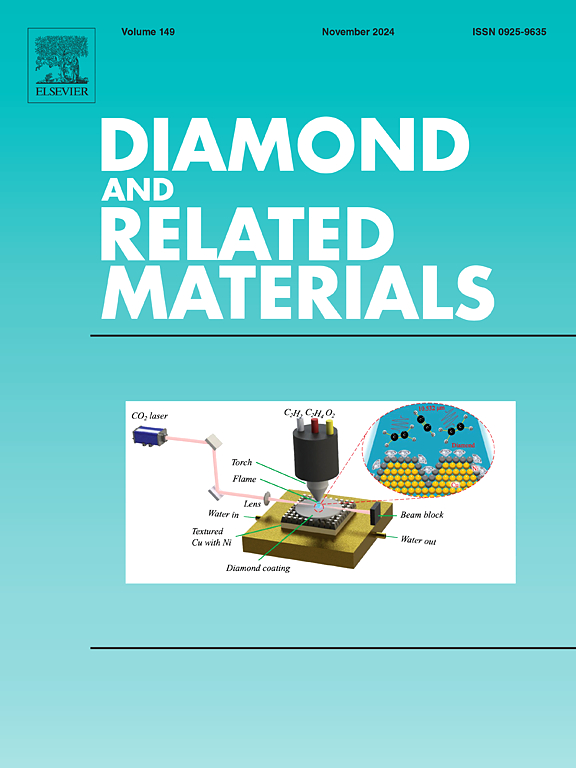SBA-15微反应器中石墨烯量子点的尺寸控制合成及印迹聚合物荧光传感器双酚A识别
IF 4.3
3区 材料科学
Q2 MATERIALS SCIENCE, COATINGS & FILMS
引用次数: 0
摘要
本研究建立了测定双酚a (BPA)的荧光分析策略。该荧光传感器利用SBA-15作为微反应器制备尺寸可控的石墨烯量子点(GQDs),然后以BPA为模板,通过沉淀聚合合成gqd载体聚合物(BPA- mip)。荧光法在0.5 ~ 20.00 μmol L−1的浓度范围内与双酚a有直接的相关性,检测限为0.180 μmol L−1,定量限为0.564 μmol L−1。荧光衰减分析显示,GQDs的寿命τ为31.87 ns, BPA- mip (0.8 μmol L−1 BPA)的寿命τ为31.64 ns,寿命缩短表明该传感器具有动态猝灭行为,从而证实了该传感器检测BPA的能力。该方法重复性好,日内和日间相对标准偏差分别为1.18%和2.01%,证实了该荧光传感器的可靠性。选择性分析表明,该荧光传感器对双酚a的测定是非常有效的。该荧光传感器探针有效地应用于3种加标饮料样品,回收率在100.40% ~ 104.80%之间。本文章由计算机程序翻译,如有差异,请以英文原文为准。
Size-control synthesis of graphene quantum dots in SBA-15 micro-reactor and fabrication of imprinted polymer-based fluorescence sensor for bisphenol A recognition
This study develops a fluorescent analytical strategy for the determination of bisphenol A (BPA). The fluorescence sensor utilizes SBA-15 as a micro-reactor to fabricate size-controlled graphene quantum dots (GQDs), followed by the synthesis of a GQD-supported polymer (BPA-MIP) via precipitation polymerization using BPA as the template. The fluorescence method demonstrated a direct correlation in the concentration range of 0.5 to 20.00 μmol L−1 for BPA, with a limit of detection (LOD) of 0.180 μmol L−1 and a limit of quantification (LOQ) of 0.564 μmol L−1. Fluorescence decay analysis revealed a lifetime (τ) of 31.87 ns for GQDs and 31.64 ns for BPA-MIP (0.8 μmol L−1 BPA), with the reduced lifetime indicating dynamic quenching behavior, thereby confirming the sensor's capability for BPA detection. The method demonstrated excellent repeatability, with intra- and inter-day relative standard deviations of 1.18 % and 2.01 %, respectively, confirming the reliability of the developed fluorescence sensor. The analysis of selectivity revealed that the proposed fluorescence sensor is highly effective for BPA determination. The proposed fluorescence sensor probe was effectively utilized to three spiked beverage samples, resulting in satisfied recoveries between 100.40 % and 104.80 %.
求助全文
通过发布文献求助,成功后即可免费获取论文全文。
去求助
来源期刊

Diamond and Related Materials
工程技术-材料科学:综合
CiteScore
6.00
自引率
14.60%
发文量
702
审稿时长
2.1 months
期刊介绍:
DRM is a leading international journal that publishes new fundamental and applied research on all forms of diamond, the integration of diamond with other advanced materials and development of technologies exploiting diamond. The synthesis, characterization and processing of single crystal diamond, polycrystalline films, nanodiamond powders and heterostructures with other advanced materials are encouraged topics for technical and review articles. In addition to diamond, the journal publishes manuscripts on the synthesis, characterization and application of other related materials including diamond-like carbons, carbon nanotubes, graphene, and boron and carbon nitrides. Articles are sought on the chemical functionalization of diamond and related materials as well as their use in electrochemistry, energy storage and conversion, chemical and biological sensing, imaging, thermal management, photonic and quantum applications, electron emission and electronic devices.
The International Conference on Diamond and Carbon Materials has evolved into the largest and most well attended forum in the field of diamond, providing a forum to showcase the latest results in the science and technology of diamond and other carbon materials such as carbon nanotubes, graphene, and diamond-like carbon. Run annually in association with Diamond and Related Materials the conference provides junior and established researchers the opportunity to exchange the latest results ranging from fundamental physical and chemical concepts to applied research focusing on the next generation carbon-based devices.
 求助内容:
求助内容: 应助结果提醒方式:
应助结果提醒方式:


